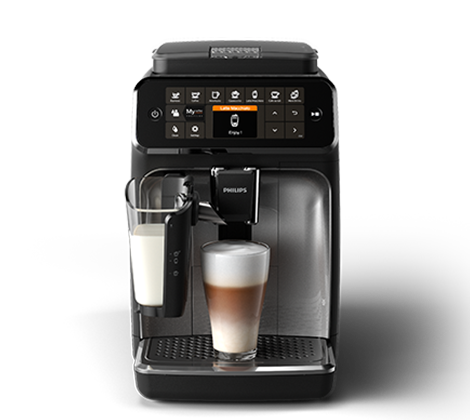#1: Philips 3200

- Easy to use
- Affordable
- Compact design
#2: Philips 4300

- More drink options
- Intuitive touchscreen
- Customizable settings
When I was in the market for a new coffee machine, the Philips 3200 and Philips 4300 quickly became my top contenders. Both machines had impressive features, a sleek design, and the promise of delivering high-quality espresso at home. After weighing the options, I decided on the Philips 4300, and I’m here to share my experience and why I believe it’s a better choice.
First Impressions and Setup: Philips 3200 vs 4300
As soon as I unboxed the Philips 4300, I noticed its polished design and high-quality materials. The machine felt sturdy and well-made, with a straightforward setup process. For someone who isn’t particularly tech-savvy, the setup was refreshingly simple, taking less than ten minutes to get everything ready.
I had a chance to compare the Philips 3200 with the 4300, and the differences became clear from the start. While both machines look compact and are designed to fit well in small spaces, the Philips 4300 offered a more intuitive interface with its TFT display, which I found incredibly helpful. Instead of simple indicator lights like on the 3200, the 4300’s display offered clear visual cues and step-by-step guidance, making it easier to get comfortable with the machine.

Philips 3200 vs 4300: Coffee Customization Options
One of the biggest advantages of the Philips 4300 is its extensive customization options. While the Philips 3200 covers the basics with five beverage choices (espresso, coffee, cappuccino, latte macchiato, and hot water), the 4300 gives you more to explore, with eight different drinks, including Americano, caffé crema, and ristretto. For someone like me who enjoys switching things up, the broader selection made my coffee routine feel a bit more exciting.
The Philips 4300 also offers more precise control over the coffee’s strength and aroma, with five aroma strength levels compared to the three levels on the 3200. This might seem like a small difference, but it makes a big impact when experimenting with different coffee beans and roasts. For lighter roasts, I could easily turn up the aroma strength to bring out more flavor, while for darker roasts, I had the option to dial it back for a smoother cup. the

Philips 3200 vs 4300: User Profiles for a Personalized Experience
One of my favorite features on the Philips 4300 is the ability to save user profiles. With two personalized profiles and a guest profile, I could save my preferred settings for drinks, which saved time and ensured a consistently great cup of coffee. This was especially handy since my partner prefers a stronger coffee than I do, and with user profiles, switching between our preferences was seamless.
In contrast, the Philips 3200 doesn’t offer user profiles, which means adjusting the settings manually each time someone else wants to use the machine. While it’s still possible to get a great cup from the 3200, the lack of profiles makes the 4300 a better choice for households with multiple coffee drinkers.
Philips 3200 vs 4300: Grind and Aroma Control
Both models come with a high-quality ceramic grinder with 12 adjustable grind settings, which allows for fine control over the grind size. This feature is fantastic for anyone who wants to experiment with different coffee textures. However, the Philips 4300’s five aroma strength levels allowed me to customize each cup to a finer degree. I found this particularly helpful when making espresso, as it allowed me to adjust the intensity to match my mood or preference for the day.
Milk Frothing Systems: LatteGo vs Classic Milk Frother
Both the Philips 3200 and 4300 offer two milk frothing options: the LatteGo system and a classic manual frother. I went with the LatteGo version on the Philips 4300 because I wanted a hands-free experience, and it didn’t disappoint. The LatteGo system is easy to use and produces consistently creamy, smooth milk foam for lattes and cappuccinos.
For those who enjoy controlling the texture of their milk froth, the classic frother is available on both models, allowing for more hands-on customization. I chose LatteGo for the convenience factor, but having both options available makes either machine adaptable for a wide range of users.
Cleaning and Maintenance: Philips 3200 vs 4300
One of my concerns with any coffee machine is maintenance, and here’s where both the Philips 3200 and 4300 excel. Both models have removable brewing units, drip trays, and water tanks, which make them easy to clean. I also appreciated that the LatteGo milk system has no tubes, making it far simpler to rinse and keep clean.
Both machines are compatible with the AquaClean filter, which extends the time between descaling. With the AquaClean filter, I didn’t have to worry about descaling for up to 5,000 cups, which is a huge time-saver.
Space-Saving Design: Philips 3200 vs 4300
For those with limited kitchen space, both the Philips 3200 and 4300 have compact designs, making them ideal for smaller kitchens. The machines are nearly identical in size, so if counter space is a concern, both are excellent choices. I found the Philips 4300 slightly heavier, but this was hardly noticeable and didn’t impact my ability to move it around if needed.
Ideal User for Each Model
Based on my experience, the Philips 3200 is a solid choice for someone new to espresso machines or for those who don’t need a wide range of customization options. It’s easy to use and covers all the basics, making it a dependable option for someone who wants a quick and simple coffee-making experience.
On the other hand, the Philips 4300 is ideal for those who want more control over their coffee and enjoy experimenting with different settings. The added features like the TFT display, extra beverage options, and user profiles make the 4300 a more versatile choice. If you’re looking for a machine that can cater to different preferences and offer a richer coffee experience, the Philips 4300 is definitely worth the investment.

Product Review Conclusion: Philips 3200 vs 4300
In conclusion, while both the Philips 3200 and 4300 are fantastic coffee machines, the Philips 4300 stands out with its broader range of options, enhanced customization, and user-friendly interface. For someone who appreciates the ability to personalize their coffee experience and values convenience, the Philips 4300 is a worthwhile upgrade over the 3200.
From the intuitive TFT display to the extensive drink choices and user profiles, the Philips 4300 has become a valued part of my morning routine. While the Philips 3200 remains a strong choice for those who want a straightforward machine, the extra features in the 4300 make it the better choice for coffee lovers seeking a more tailored experience.
FAQ
Q: What are the main differences between the Philips 3200 and Philips 4300?
A: The main differences are in the customization options and user interface. The Philips 4300 has a TFT display for easier navigation, offers more drink options (8 compared to the 3200’s 5), and includes user profiles so multiple people can save their preferences. The 3200 has a simpler light-based interface and fewer customization features.
Q: Does the Philips 4300 have more drink options than the Philips 3200?
A: Yes, the Philips 4300 offers 8 drink options, including Americano and ristretto, whereas the Philips 3200 provides 5 options like espresso, coffee, and cappuccino. If you want a broader variety of drinks, the 4300 is a better choice.
Q: Which machine has better customization for coffee strength and aroma?
A: The Philips 4300 has more customization with 5 aroma strength levels, allowing for finer adjustments compared to the 3 aroma strength levels on the 3200. This gives users more control over coffee intensity.
Q: Are there any differences in milk frothing systems between the Philips 3200 and 4300?
A: Both the Philips 3200 and 4300 are available with the LatteGo milk frothing system or a classic milk frother, so they offer the same frothing options. The LatteGo system is automatic and user-friendly, while the classic frother allows for manual control over the milk texture.
Q: Do both models have the same grinder?
A: Yes, both the Philips 3200 and 4300 have ceramic flat burr grinders with 12 adjustable grind settings. This allows users to adjust grind size according to their preference, ensuring both models offer similar grinding quality.
Q: Is there a difference in the display interface between the Philips 3200 and 4300?
A: Yes, the Philips 4300 has a TFT color display that shows clear instructions and feedback, making it more user-friendly. The 3200, on the other hand, has a simpler display with light-based indicators, which can be less intuitive for first-time users.
Q: Can I save user profiles on both the Philips 3200 and 4300?
A: No, only the Philips 4300 offers user profiles, allowing multiple users to save their personalized drink preferences. This is convenient for households with more than one coffee drinker. The Philips 3200 does not have this feature, so settings need to be adjusted manually each time.
Q: How do the machines compare in terms of cleaning and maintenance?
A: Both machines are designed for easy maintenance, featuring removable brew groups and drip trays, and many parts are dishwasher safe. Additionally, both support the AquaClean filter, which reduces the need for frequent descaling.
Q: Is there a difference in size between the Philips 3200 and 4300?
A: The Philips 3200 and 4300 are almost identical in size and designed to fit well on countertops. The 4300 is slightly heavier, but both models are compact and suitable for smaller kitchens.
Q: Is the price difference between the Philips 3200 and 4300 worth it?
A: The Philips 4300 is generally more expensive due to its added features, such as the TFT display, additional drink options, user profiles, and greater customization. If these features align with your preferences, the added cost can be justified. However, the Philips 3200 remains a solid choice for those who need only the basics.
Q: Do both models have a bypass option for pre-ground coffee?
A: Yes, both the Philips 3200 and 4300 include a pre-ground coffee bypass. This feature allows users to brew coffee using pre-ground beans, making it convenient for decaf or specialty blends.
These FAQs provide a clear comparison between the Philips 3200 and 4300, highlighting the key differences and helping users determine which model best suits their coffee-making needs.
